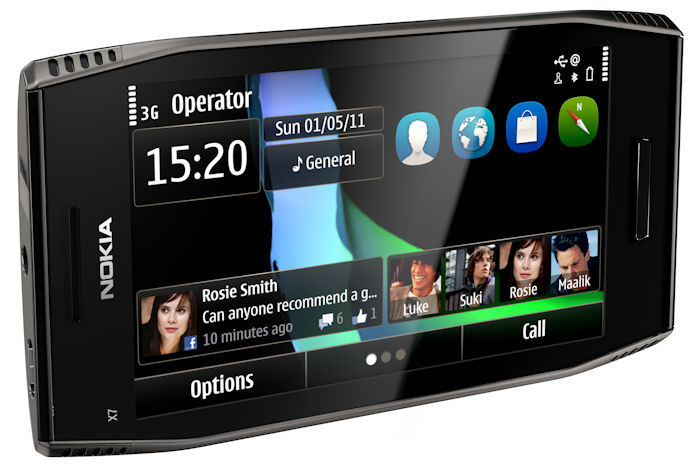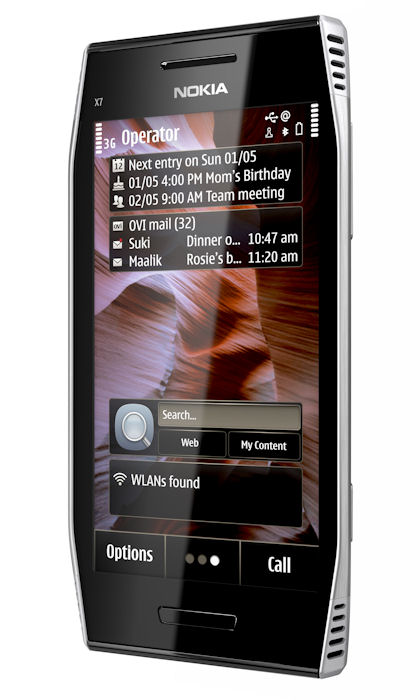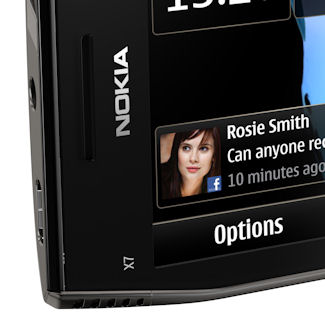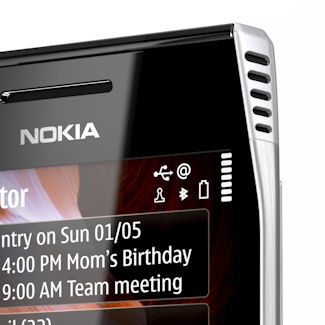The X7 is the new top of the range model for Nokia Xseries, devices positioned as entertainment (music, video and gaming) and social devices. The X7 is the first Symbian^3 device in the Xseries family and represents a very significant step up from the X6. It runs on the same hardware family (processor, RAM) and core software as other Symbian^3 devices; with the positioning largely achieved through the combination of design and styling.
In the case of the X7, the key hardware feature is the four inch AMOLED screen, the largest of any Nokia touch only device. Nokia have reduced the air gap between the display and the gorilla glass, which gives the display a more vibrant look. Where the N8 and E7 stand out because of their camera and keyboard respectively, the X7 is intended to stand out because of its design. Design is a subjective area, but in the hand the X7 is markedly different from the standard black rectangle that is typical of such large screen slab devices.
The four inset corners give an angular effect and make the device look a little smaller than it really is. For a four inch screened device it fits surprisingly comfortably into the hand, thanks to a gently curved stainless steel back. Together with the Gorilla Glass front, the overall impression is of solidity and durability.
In overall form factor, the Nokia X7 is the closest Nokia has come to producing a device similar to HTC's big Android slabs (and, to a lesser extent, Apple's iPhone). This smartphone slab space, sometimes referred to as the superphone space, is extremely competitive. When compared to other devices, the X7 might be considered to fall short in terms of raw specifications (processor, screen resolution), but in broad terms there's a similar level of functionality and the X7 has a competitive price point.
No doubt the fact that the X7 runs Symbian, even with the latest set of upgrades, will continue to be perceived negatively in many quarters. Such views lack depth and tend to ignore the complex structure and highly differentiated nature of the global smartphone market. As with Nokia's first batch of Symbian^3 devices, the X7 is far less about gaining users from devices running on the competing platforms and far more about retaining existing Nokia users and gaining totally new customers.
Ultimately, the X7 gives another option in the Symbian^3 device family, which now encompasses a wide range of device form factors and consumer use cases. Taking all six current Symbian^3 devices, and the promise of more devices to come, it is not difficult to understand Nokia's confidence in its ability to sell another 150 million Symbian devices.

Key hardware features
- 119.7 x 62.8 x 11.9 mm in dimensions, 146g in weight; monoblock touch form-factor.
- Glass and metal materials (Gorilla Glass front screen, curved stainless steel back) with a 'premium design'.
- 4 inch, AMOLED touchscreen; 640x 360 pixels resolution (nHD)
- 8 megapixel full focus (EDoF) camera with dual LED flash; video recording at 720p resolution (1280×720) and 25 frames per second.
- Integrated GPS with location support for GPS, A-GPS, WLAN and Cell-ID location techniques.
- 3.5 mm Nokia AV connector for audio in/out and TV-out
- FM Radio (with RDS)
- microUSB (USB 2.0) for file transfers, charging and USB On-the-Go
- Integral (non user-removable) BL-5K (1200mAh) battery (standby by time of 18.75 days, talk time of 9.5 hours (GSM) and 4.8 hours (WCDMA), music playback up to 50 hours, video playback upto 6 hours. Charging via microUSB port.
- WCDMA 850/900/1700/1900/2100 and GSM/EDGE 850/900/1800/1900 (HSDPA Cat 9 - 10.2 MBps, HSUPA Cat 5 - 2.0 Mbps)
- WiFi: WLAN IEEE802.11 b/g/n and Bluetooth 3.0
- Processor: Broadcom BCM2727 - ARM 11 at 680MHz with 3D Graphics HW Accelerator with OpenGL-ES 2.0 support (i.e. graphics co-processor).
- microSD card slot (comes with 8GB card, supports sizes upto 32GB)
- Up to 350MB Internal Memory, 256MB RAM
- Initially available in two colours: Dark Steel and Light Steel
- Box contents: Nokia X7-00, Nokia Battery BL-5K battery (built in), Nokia Connectivity Cable CA-179, 8GB microSD card, Nokia Stereo Headset WH-701, Nokia Fast Micro USB Charger AC-10
Key software features
- Runs Symbian Anna (roughly equivalent to Symbian^3 PR 2.0)
- Symbian Anna additions and updates include a fresh icon set, improved text input usability (portrait QWERTY and split screen text entry), an easier to use and faster browser, the latest version of Ovi Maps (3.6 - improved search and public transport on maps), improved enterprise security features and messaging, and the latest version of Qt.
- Symbian^3 improvements over S60 5th Edition (Symbian^1) include the renewed music experience (e.g. coverflow albums), the visual task switcher (see contents of application from the task switcher), multi-page homescreen, a more streamlined menu structure with fewer prompts (e.g. no connectivity prompts), a single tap 'Direct UI' paradigm (compared to the double tap Symbian^1), memory and battery efficiency improvements (e.g. writeable demand paging).
- A full multimedia software suite (Music player, Video player, Gallery, Photo and Video editors, Flash Lite 4, Web TV widgets and FM Radio. Formats supported include H.264, MPEG-4, VC-1, H.263, Real Video 10, ON2 VP6, Flash (video) and MP3, AAC, EAAC, eAAC+, WMA, AMR-WB and AMB-NB (audio). DRM support for WM DRM and OMA DRM 2.0.
- Ships with Ovi Maps 3.6 (free lifetime car and pedestrian navigation) and a number of other Ovi services (Music, Store, Messaging).
- Ships with the third party games Galaxy on Fire and Asphalt 5 HD pre-installed.



